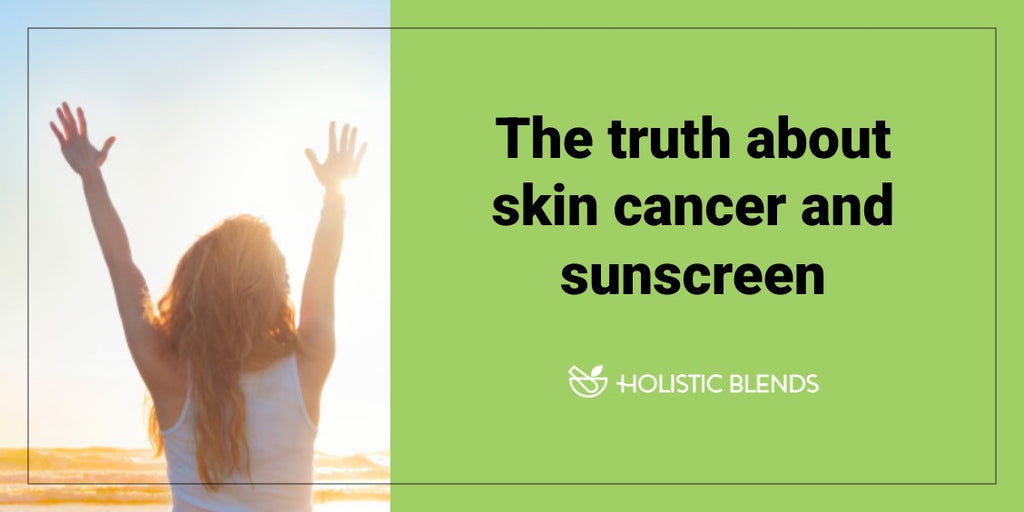I’ve probably told you this before, but I’m a people watcher.
Not in a strange way! Instead I observe people’s behaviors from an educational perspective, especially as they relate to health and lifestyle habits.
I was at the beach recently and noticed that, with very few exceptions (including myself), everyone around me was diligently and regularly applying their sunscreen.
And all I could think to myself is, “Fear is an excellent marketing tactic.”
Over the last few decades, we have been bombarded with the doomsday message that “skin cancer” is deadly, it’s caused by sun exposure, and your only saving grace is to use sunscreen.
Let’s pick that apart a little bit, shall we?
The birth of sunscreens
Sunscreen arrived on the scene in 1936, being introduced by French chemist Eugène Schueller—the founder of L'Oreal cosmetics.
So you would expect that prior to 1936, people must have been keeling over in huge numbers from skin cancer, right?
Wrong.
In fact, according to Dr. Marc Sorenson, founder of the Sunlight Institute and author of the book, “Embrace the Sun,” in 1935 (one year before the introduction of sunscreens) about 1 in 1,500 people contracted melanoma.
As of 2002, 66 years after sunscreens hit the market, that rate was 1 in 50!
In addition, between 2006 and 2015, melanoma rates increased 3 percent per year, so clearly rates are going up—despite the fact that we are using MORE sunscreen than ever before in our existence.
Something is not adding up here.
Skin cancer is an umbrella term
All skin cancer is not created equal, and the expression “skin cancer” is an umbrella term.
There are actually three types of skin cancer—basal cell carcinoma (BCC), squamous cell carcinoma (SCC) and melanoma (by far the most dangerous type).
Here’s the scoop on each:
Basal cell carcinoma (BCC)
Basal cell carcinoma (BCC) is the most common skin cancer, making up 80 percent of cases. BCC risk factors include excessive sun exposure, having fair skin and a family history. BCC typically occurs in sun-exposed areas like the face.
BCC rarely metastasizes, and although it may recur after treatment, it has a near 0 percent fatality rate.
Squamous cell carcinoma (SCC)
Squamous cell carcinoma (SCC) is the second most common type of skin cancer.
Unlike BCC, SCC can metastasize, making it potentially more dangerous.
If it’s removed before it spreads, the survival rate is 99 percent. After metastasis, that drops to 56 percent.
But it is typically caught early, and has an average survival rate of 95 percent.
Melanoma
Melanoma is the rarest form of skin cancer, occurring at a rate of 218 cases per million people in the US.
Survival rates range from 99 percent to 35 percent, depending on when it’s diagnosed, with an average survival of 94 percent.
Despite making up only 1 percent of all skin cancer cases, melanoma is responsible for the most skin cancer deaths, totaling around 8,000 deaths in the US each year.
But here are some eye-opening facts: 75 percent of all melanoma cases occur on areas of the body that NEVER see the sun.
Plus indoor workers have DOUBLE the rate of lethal melanoma than outdoor workers (who are in the sun all day)!
Clearly there are some holes in the skin cancer/sun exposure story.
As far as sunscreen use goes, studies have shown that sunscreen may help reduce the number of new squamous cell skin cancers, but has little to no effect on basal cell carcinomas, and may actually contribute to the development of the more aggressive melanoma!
The dark side of avoiding the sun
Avoiding the sun does have a dark side because your body needs UV light exposure from the sun to make vitamin D.
Vitamin D protects you against cancer, so by avoiding the sun because you’re scared of skin cancer, you’re actually in effect raising your overall risk of cancer!
Plus vitamin D is crucial for bone health, mental health, a robust immune system and a healthy cardiovascular system, among other things.
Here is an interesting tidbit: It has been estimated that for every death caused by diseases related to excessive sun exposure — such as melanoma—there are 328 deaths caused by diseases of sunlight deprivation and lack of vitamin D!
All sunscreens are not created equal
Many sunscreens are not only wildly ineffective, but up to 75 percent of them are downright toxic!
First of all, a product needs to shield you from both UVA and UVB radiation. But some sunscreens only protect against UVB rays, which are the rays that your body uses to make vitamin D, and not protecting you from UVA rays—which are the rays that can cause skin cancer.
To protect against UVA, you need to use a broad-spectrum product that specifies protecting against UVA. Unless it specifically says so, you can assume it does not provide UVA protection.
It's also important to know that no sunscreen is capable of blocking 100 percent of UVB radiation. Generally speaking:
- SPF 30 blocks 97 percent of UVB
- SPF 50 blocks 98 percent of UVB
- SPF 100 blocks 99 percent of UVB
In addition, the following sunscreen ingredients have either been shown to be toxic, or at a minimum data supporting their safety are lacking:
- Para amino benzoic acid (PABA)
- Octyl salicyclate
- Oxybenzone (Research suggests oxybenzone is an endocrine disruptor, and it has been linked to reduced sperm count in men and endometriosis in women. Plus it is known to harm coral reefs and aquatic life.)
- Cinoxate
- Dioxybenzone
- Phenylbenzimidazole
- Homosalate
- Menthyl anthranilate
- Octocrylene
- Methoxycinnamate
- Parabens
A smart approach
Clearly, completely avoiding the sun is not necessarily in your best interest, nor is slathering potentially toxic sunscreen on your skin!
Here is a smart approach to getting healthier sun exposure and still protecting yourself:
Take care of your skin from the inside out!
Skin health starts on the inside, and that means eating lots of fresh fruits and vegetables, drinking plenty of filtered water and getting enough Omega-3 essential fatty acids.
A pure fish oil formula like VitalMega-3 can help ensure you have healthy-skin-supporting levels of these crucial fats, especially since most people don’t eat nearly enough fish to give their bodies the Omega-3 EFAs they need!
Also important for skin health are antioxidants, biotin, vitamin B6 and vitamins C and E.
Super Core multi-vitamin and mineral formula contains healthful doses of all these nutrients, plus natural antioxidants which help counteract premature aging from free radicals, and anti-inflammatories which support skin health!
Get 20-30 minutes of unprotected sun exposure each day
This will help allow your skin to naturally produce vitamin D as it was designed to.
Plus, the sun’s rays have been shown to have a positive effect on skin conditions such as psoriasis, acne and eczema, and sunlight helps to kill harmful bacteria on your skin.
In addition, sunlight also builds your immune system. Your immune system’s white blood cells (lymphocytes) increase with sun exposure, and these cells play a significant role in defending your body against infections.
Protect for longer exposure
If you stay in the sun for longer than 30 minutes, it’s wise to protect yourself. Options include wearing light clothing, sitting under an umbrella, or wearing a wide-brimmed hat and sunglasses.
If you opt to use sunscreen, be sure to choose “broad protection” (UVA and UVB) mineral-based varieties that do not contain the harmful ingredients listed above. I use Badger, but there are many excellent brands out there.
The Environmental Working Group (ewg.org) has a very thorough guide on various sunscreen brands that can help you choose a safer product.
Never, EVER get a sunburn
If you see your skin going from light pink or tan to red, get out of the sun immediately and put some aloe vera and/or vitamin E gel on your skin.
Enjoy the sun the way you’re supposed to—safely and healthfully!
To your health,
Sherry Brescia












I quite agree with this article. My father worked outdoors and my mother was a keen gardener and neither of them used sunscreen. They would get a natural tan, but never had skin cancer.
Thanks very much for your information as I have just got a BCC Cut out on my head.
Thanks again
Thanks for your clarification in this continuing subject… Very much appreciated.